 |
 |
 |
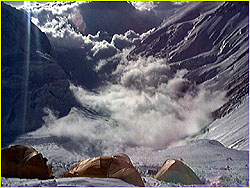 Into the Death Zone
Into the Death ZonePage 3 | Back to Page 2 May 21—5:05 am. I have the radio three inches from my ear and on full volume. "Camp III to Base Camp," startles me from my sleepless stupor. It's David and Pete and they give me their pulse oximeter readings. David has an oxygen saturation of 61% with a pulse of 99. The higher they go, the lower the percentage of oxygen in their blood. They've both slept 1.5 hours. "That's a night at Camp III without oxygen," explains David, who seems to have endless reserves of energy. Dave Carter, Tashi Tenzing, and Guy Cotter will all start breathing supplemental oxygen tonight at Camp III. The others, excluding Veikka, will begin breathing bottled oxygen at Camp IV. This commits all to a summit attempt, as the oxygen supply is limited. They'll each have three bottles to get them up and on their way from Camp IV, and three bottles to get them to the summit and back down to Camp IV. Veikka is attempting Everest without the use of supplemental oxygen. Weather reports show an estimated 45-mile-an-hour winds on the 23rd, which will be their summit day. "It's going to be D-Day on Everest," comments David Breashears on the numbers of climbers heading for the summit on the same day. "We have members of John Tinker's expedition, Canadians, Guy Cotter's team, NOVA, and the Malaysians all going up on the same day. But we're strong and we'll be ahead of everyone breaking trail." As the B-2 lies slumped like a beached whale on the rock and ice of the Khumbu Glacier, just a few hundred yards from our camp, we marvel at how the thin air 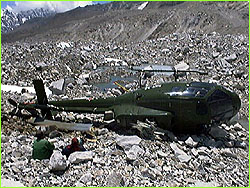 up here takes its toll on machines as much as it does on our bodies. And at
23,500 feet, 6,000 feet above us, our team members slumber inside their
sleeping bags, awaiting what will be the beginning of a sequence of arduous
events leading up to the summit of Everest.
up here takes its toll on machines as much as it does on our bodies. And at
23,500 feet, 6,000 feet above us, our team members slumber inside their
sleeping bags, awaiting what will be the beginning of a sequence of arduous
events leading up to the summit of Everest. David Breashears: "Well, I feel very good about this summit team, but I don't have a lot of inspiration myself, and you have to be inspired to do something like this and do it well. Perhaps it's too soon, too close to last year. We'll have climbed Everest twice within one year. I envy these people that are here for the first or second time; they're full of fear and of the unknown, which I'm not. But they're tremendously excited about standing on top of Everest, which I can't say that I am. I am only excited about doing my work well and getting these insights into how people perform at altitude." The South Col (Camp IV) May 22—David describes the climb from Camp III to Camp IV: "You really start to feel the altitude once you cross the Yellow Band. We climb without oxygen until the South Col, at 26,000 feet. All the clients sleep with 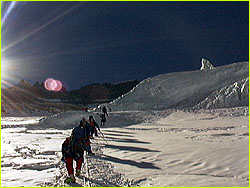 oxygen at Camp III and use it climbing to Camp IV. It makes for an easier day
for them, but I truly feel if you're going to climb Everest you owe it to
Everest and to yourself to at least experience 26,000 feet without oxygen, it's
just part of the game. If you're going to talk the talk, you might as well
walk the walk. But once you leave Camp III and by the time you hit the Yellow
Band you're really in thin air and you feel it. You have a lot more
respirations per minute, your heart beats harder, and you're just slow and you
stop to rest a lot more than on the day before getting to Camp III. So, in a
way that may be one of the hardest parts of the ascent, because after we leave
the South Col we have oxygen."
oxygen at Camp III and use it climbing to Camp IV. It makes for an easier day
for them, but I truly feel if you're going to climb Everest you owe it to
Everest and to yourself to at least experience 26,000 feet without oxygen, it's
just part of the game. If you're going to talk the talk, you might as well
walk the walk. But once you leave Camp III and by the time you hit the Yellow
Band you're really in thin air and you feel it. You have a lot more
respirations per minute, your heart beats harder, and you're just slow and you
stop to rest a lot more than on the day before getting to Camp III. So, in a
way that may be one of the hardest parts of the ascent, because after we leave
the South Col we have oxygen."Although it's called "The Death Zone" by some, we tend to call it "The Breath Zone." All radio calls are punctuated with heavy breathing, a sign of the oxygen-deprived environment the climbers have entered. The flat nature of the South Col provides a false sense of security—the jet stream winds can demolish a tent in an instant. Unfortunately, due to heavy traffic over the years, this camp is often referred to as the highest junkyard in the world. But the efforts of the past few years to carry the oxygen bottles and other garbage down from the South Col are beginning to make a difference. The climbers will most likely not sleep tonight, as they have only five hours to rest before they begin the two-hour process of getting ready to leave the South Col for their summit attempt. "It's a rough night, you're full of apprehension—not necessarily anxiety—because it's a daunting thought to be arriving at the South Col at two in the afternoon and with hardly a rest or anything to drink or eat," explains David. "Seven to nine hours later you're off again and it's not a real rest, there's no real sleep. We'll be busy filming the neuro-behavioral tests, heating up, transforming ice into water, and then really, if you're going to be ready by 11, you better be up and moving by 8:30. It takes a good two hours to get your boots on, your suit on, your mask on, and be out the door of your tent. And right now the temperatures at these elevations are averaging about 30 to 40 below zero." Before signing off for a two-hour rest on the South Col, David expresses his deep doubts about climbing to the summit with so many other climbers, something that he did everything to avoid last year. "Something is bothering me and something was bothering me May 9th 1996. There's things you really have a lot of faith in and things that you don't and I have a lot of faith in my gut feelings. I'd like to see this day sort itself out without me being a part of it. Pete and I have had a very exhausting day, as we've had to shoot all of the climbers' neuro-behavioral tests. We need time now to eat and drink and try to rest. We're not 100% sure whether we'll be going for the summit tonight, especially with these growing numbers of people and if the weather is bad." We expect a call from David at the South Col at 10:00 p.m. tonight to let us know whether they will definitely be going for the summit. If so, they will climb with head lamps and the aid of the full moon. 10:00 pm—We've just received word they're on their way. Like some sort of cryptic comedy, David's notification to us of their departure (which we were set up to film from Base Camp) is almost meaningless: David: "...way, it's a beautiful night."By process of hypoxic deduction, we assume they are on their way up. It's the only communication we have with them and we know that they have to be left alone to get themselves together, film, and start climbing in the moonlit night. 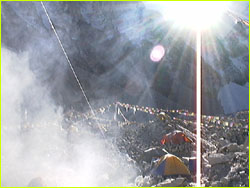 We put our pads and sleeping bags down on the rock gravel and ice floor of our
communications tent so we can be seconds away from talking to the climbers by
Motorola base station if they call. My head is inches away from the radio, and
every time the mic is accidentally keyed, I jump up and reach for the radio in
anticipation of a real call from them while they're on the move.
We put our pads and sleeping bags down on the rock gravel and ice floor of our
communications tent so we can be seconds away from talking to the climbers by
Motorola base station if they call. My head is inches away from the radio, and
every time the mic is accidentally keyed, I jump up and reach for the radio in
anticipation of a real call from them while they're on the move. Outside, at Base Camp, rock chortens (altars) burn brightly with sacred juniper branches while the clouds dissipate above us, as if being burned off by the rays of the bright moon. For the first time, Base Camp is silent—no creaks or groans from the glacier, no crashing rock falls, and no roaring avalanches. All is as still as can be, except the crackling of the juniper branches, as if in anticipation of the night's climb. Ed Viesturs Describes the Summit Day "We leave at night so that we can get down before it gets dark."—Ed ViestursWe allow ourselves 12 hours to get to the summit. We think that is a reasonable amount of time and that uses about two bottles of oxygen and that gives us one bottle of oxygen to come down with (with plenty of safety margin). It should only take perhaps four hours to come down but with leaving at 11 o'clock we would have then six hours to get down before it gets dark. If anything happens, we have plenty of time. You would think that if you stretched the summit day longer than 12 hours, by bringing more oxygen you could climb for 18 hours but by then people would be very tired, very exhausted and it wouldn't give you any margin of safety for coming down. So we begin the ascent around 11 p.m. and we're about halfway to the summit when the sun rises. We crest the Southeast Ridge and we can see Makalu and Kanchenjunga and the sun comes up and it's a really spectacular day. From there we continue on to the Southeast Ridge, over the South Summit." "A lot of people say that climbing Everest is a cake walk, and it is not very difficult. In my opinion, it is extremely good climbing. You have to be a good climber to climb Mt. Everest safely. It's steep, it's exposed, there's rock, there's snow, there's ice. Not anybody can just put on an oxygen mask and climb Everest. It's very dangerous to assume that. It's quite a beautiful climb on the summit ridge. From the South Summit (which is 300 ft. below the summit) it takes another hour or two to get to the summit. That is probably the most exposed climbing. It is a very steep traverse on a knife edge ridge. Then we climb what is called the Hillary Step—about a 30-foot vertical snow and rock step. At 28,800 feet it is quite demanding and difficult and quite steep and vertical on both sides. So, it is quite an airy ascent. From there, it is a relatively moderate slope (about 30 degrees) to the summit (probably 200-300 yards of just cruising climbing)." "At those altitudes you're going quite slowly. You take a breath and you breathe six to eight times and then you take another step and then you breathe six or eight times and then often you just think about taking another step and then you breathe six or eight times and then you finally take that step. It's quite a physical and mental effort just to think about taking each individual step. That's what you have to break the summit day down into. You can't look at the whole ascent. You have to break it down into small sections and into tiny little steps. That's how you eventually chew your way to the summit." "On a good day, I've spent as long as an hour and a half on the top. If there is good weather, if we have plenty of time we hang out for an hour or so and take pictures. If it is a bad day, we might spend five minutes up there. It's hard to really relax. You're happy that you're there but you can't really relax and let your guard down because you still know that you have to get down. I always tell people that getting to the summit is optional but getting down is mandatory. A lot of people forget the fact that climbing down is often as hard as climbing up. They use all their energy to get to the summit and then that's it. And for me, it doesn't count if you don't get down. It's very important to remember that." 5:20 am—David finally calls in from the South Summit at 27,800 feet. It is a hasty call, as they want to keep moving. 6:50 am—The call we've been waiting for finally comes through, "I'm standing 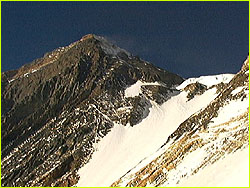 on top of the world!" It's David and a world of listeners on the internet are
with him on the summit.
on top of the world!" It's David and a world of listeners on the internet are
with him on the summit.The climbers call us from the South Summit on their way down and we begin conducting their neuro-behavioral tests. How strange it is to hear them repeating, "If you have occasion to visit the tropics, try to go when ocean breezes make sailing fun," from that point on Earth. Time is precious and my heart only wants to know how they feel and what it's like up there. The short term memory sentences ring through the radio like some absurd game our science advisors are playing on us. ("I know, let's have them say completely ridiculous things at 28,500 feet.") Perhaps refusing to do them means you've passed the test. I sit silently scoring the pages as Howard Donner administers, and the climbers, somewhat willingly, oblige. 11:50 am—David calls and he and Jangbu are back safe and sound at the South Col. "It was the toughest day of my life. I'm too exhausted to get into my tent, I'm just lying here in the scree, five feet from my tent." But just at the moment when we thought all of our worries were over, Dave Carter's toughest moments in his life were about to begin. A two-day round-the-clock vigil of climbers and Base Camp doctors who were communicating with David and Ed by radio as they slowly progressed down the mountain, was the smallest part of what took place. Dave had an airway blockage that occurred several times, completely obstructing his airway passage, leaving him unable to breathe. A simple upper respiratory infection that Dave had acquired at Base Camp was compounded by the effects of climbing in extreme altitudes: malnutrition, dehydration, sleeplessness, and his immune system was gravely impaired. "I wasn't sure I was going to make it," confesses Dave, who is now safely down at Base Camp and should be able to walk out. "I haven't even thought once about making the summit, it's just not what is important to me anymore. Being here, being in the mountains and climbing is something I love and will always do. But it will take a long time before it sinks in that I summited Everest." For Carter, as for all of us who seem to keep coming to altitudes where no human populations can thrive, we all ultimately have to come back down. Watch the NOVA documentary detailing this story of humans at high altitude, scheduled for broadcast next winter. Check the TV Schedule in September for an exact broadcast date. Photos: (1,4,10,12,14) Pete Athans; (2,3,5,6,8,11,13) Liesl Clark; (7) Howard Donner, MD; (9) David Breashears. Lost on Everest | High Exposure | Climb | History & Culture | Earth, Wind, & Ice E-mail | Previous Expeditions | Resources | Site Map | Everest Home Editor's Picks | Previous Sites | Join Us/E-mail | TV/Web Schedule About NOVA | Teachers | Site Map | Shop | Jobs | Search | To print PBS Online | NOVA Online | WGBH © | Updated November 2000 |